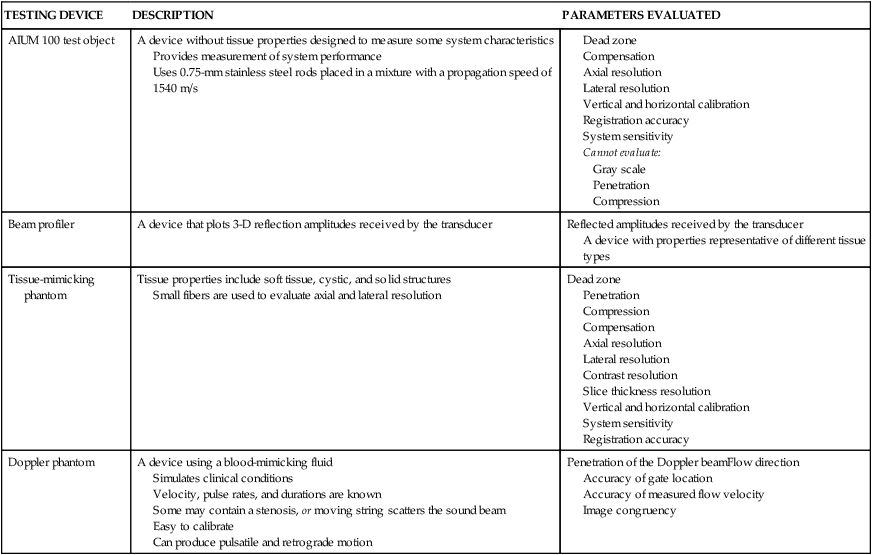CHAPTER 6 a device that plots the reflection amplitudes received by the transducer. distance closest to the transducer in which imaging cannot be performed. testing device that measures acoustic output. testing used to collect data on the operation and acoustic output of the ultrasound system. tissue-equivalent testing device with characteristics that are representative of tissues. preventive maintenance (PM) service ability to place echoes in proper position when imaging from different orientations. measure of how weak a reflection the system can display. • Considers only the pulser and transducer. • Evaluates the safety and biological effects of ultrasound and Doppler imaging. • Requires specialized equipment and is generally performed by the manufacturer. Methods for Evaluating Operation Methods for Evaluating Acoustic Output • Positive means the test predicted disease. • Negative means the test predicted the absence of disease. • True positive (TP) means test matches gold standard—both are positive for disease. • True negative (TN) means test matches gold standard—both are negative for disease. • False positive (FP) means test does not match gold standard—the test says there is disease when there isn’t. • False negative (FN) means test does not match gold standard—the test says there is no disease when there is. Sensitivity: ability of a test to detect disease. Specificity: ability of a test to detect the absence of disease. Positive Predictive Value: measures how often the test is correct when positive for disease. Negative Predictive Value: measures how often the test is correct when negative for disease. Accuracy: measures the percentage of examinations that agree with the gold standard. • American Institute of Ultrasound Medicine (AIUM) and American College of Radiology (ACR) have adapted universal scanning protocols for medical sonography examinations. • Extension of these protocols may be necessary when anomalies, abnormalities, and pathologies are discovered.
Quality assurance, protocols, and new technologies
Methods of evaluation
Operation testing
Acoustic output testing
TESTING DEVICE
DESCRIPTION
PARAMETERS EVALUATED
AIUM 100 test object
A device without tissue properties designed to measure some system characteristics
Provides measurement of system performance
Uses 0.75-mm stainless steel rods placed in a mixture with a propagation speed of 1540 m/s
Beam profiler
A device that plots 3-D reflection amplitudes received by the transducer
Reflected amplitudes received by the transducer
A device with properties representative of different tissue types
Tissue-mimicking phantom
Tissue properties include soft tissue, cystic, and solid structures
Small fibers are used to evaluate axial and lateral resolution
Dead zone
Penetration
Compression
Compensation
Axial resolution
Lateral resolution
Contrast resolution
Slice thickness resolution
Vertical and horizontal calibration
System sensitivity
Registration accuracy
Doppler phantom
A device using a blood-mimicking fluid
Simulates clinical conditions
Velocity, pulse rates, and durations are known
Some may contain a stenosis, or moving string scatters the sound beam
Easy to calibrate
Can produce pulsatile and retrograde motion
Penetration of the Doppler beamFlow direction
Accuracy of gate location
Accuracy of measured flow velocity
Image congruency

TESTING DEVICE
DESCRIPTION
PARAMETERS EVALUATED
Force-balance system
A device that measures the force (pressure) of the sound beam
Measures the intensity or power of the sound beam
Hydrophone
A small transducer element mounted on the end of a hollow needle or a large piezoelectric membrane with small metallic electrodes centered on each side
Membrane is made of polyvinylidene fluoride (PVDF)
Relationship between the amount of acoustic pressure and the voltage produced
Measures acoustic output
Measures pressure and intensities across the sound beam
Measures period, pulse repetition period, and pulse duration
Record keeping
Statistical indices





Protocols
![]()
Stay updated, free articles. Join our Telegram channel

Full access? Get Clinical Tree


Quality assurance, protocols, and new technologies
